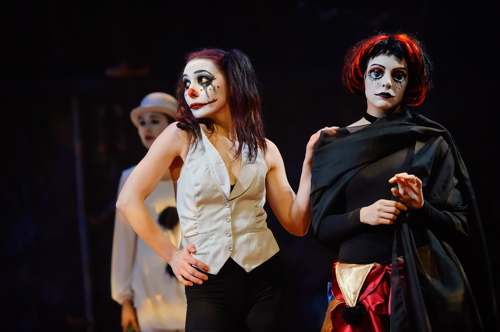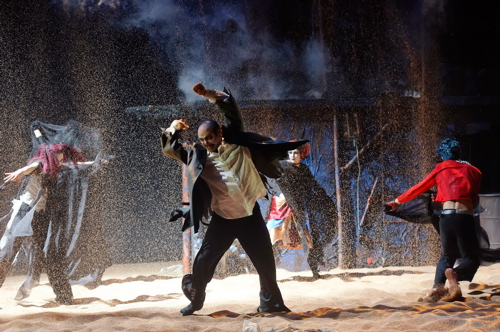There’s a point in the life cycle of a theater company when its style is well-established and admired. Audiences get it, enamored of the new elements that it brings to the city’s art scene. Awards are achieved, a new home is granted. That’s the tipping point, when its time for the critic to stop focusing so much on the uniqueness of the company’s innovation, and for the artists to start thinking about the next direction. In other words – let’s stop looking at the dress, and examine the body underneath.
I am at that point with Synetic Theater, a company I dearly love, and whose success I feel strongly about. But after seeing King Lear, I wonder if it’s time to pause the still well-deserved accolades for their physical style, and highlight where they could use some growth.
It isn’t quite a case of the Emperor’s New Clothes yet. Certainly there’s a ravishingly sick beauty to this production, with its Fellini meets Tim Burton inspiration, and the usual haunting images and moments of physical power we’ve come to expect and indeed demand from Synetic. But, it’s just that – usual. Now that this style is the baseline expectation for Synetic, and because we expect that level of brilliance in the conceptual presentation, the holes with plot interpretation are starting to show.
And with next season full of repeats of popular productions past before debuting a winter program called New Movements: New Directors, New Voices, I wonder if the company itself is beginning to feel its time to take stock.

Mirenka Cechova as Fool, Irina Tsikurishvili as Regan, and Ira Koval as Goneril in Synetic Theater's production of King Lear. Photo credit: Graeme B. Shaw.
King Lear is one of Shakespeare’s most challenging plays and certainly one of the canon’s most demanding roles. Every director handles these two facets – action and characters – differently. One may choose to highlight the family dynamics, which can be either simply dysfunctional or a treasure trove of soap operatic nightmare. Another may choose to highlight the loss of vigor that aging brings, the sadness and madness of letting go of youth and succumbing to death. Obviously the latter is pretty scary, the former is more fun. Most choose the former, having a field day with the characterizations of “evil” sisters Goneril and Regan or bastard Edmund, tilting the play into grand guignol.
Reading King Lear I hear very eloquently Shakespeare himself aging, bemoaning the loss of his youthful power and raging against the injustice of life’s passing. With the exception of one powerful scene in this production (which notably brought the house to applause), that’s not the Lear you’ll get here. Instead you’ll get a lot of hyperactive gusto concentrating on the sisters, and a strange choice to make youngest daughter Cordelia a male Cordelio – complete with a forbidden lover clearly costumed to imitate Michael Hayden in the STC’s recent Richard II, the production design’s one major misstep. It’s a theatrical in-joke that takes the character awkwardly out of the world created. (NOTE: Since publication, company member Alex Mills has stated in the comments that this is an incorrect assumption and that the designer did not reference that costume. This was my opinion only.)
Sure, it’s amazingly beautiful in the freakish way the design channels a blown-out Fellini world with clowns and a Death to give you nightmares. Set designer Phil Charlwood has created a bombed-out land with a stage full of sand, the perfect background for the circus troupe from hell. But more often than not, the action is played for laughs. Some really effective laughs – as with the energetic dance-off between spoiled sisters Goneril (Irina Tsikurishvili) and Regan (Ira Koval) as they fight for their father’s attention (or rather, his land and crown). The dance-off allows choreographer Irina Tsikurishvili to play with more different dance styles than she usually does, and because of that it plays incredibly fresh, a mashed-up Michael Jackson-Bob Fosse motif complete with jazz hands. In the same vein is the industrial dance party Lear interrupts to tragic results, where Regan and and her husband the Duke of Cornwall (Ryan Tumulty) show their true colors in a dance scene that’s like the Peanuts on cocaine.

Hector Reynoso as Gloucester and Ben Cunis as Edgar in Synetic Theater's production of King Lear. Photo credit: Graeme B. Shaw.
As usual the ensemble acting is a chief joy. Lear’s Fool is played by the expressive Mirenka Cechova as an innocent mime and the sad witness to the family’s destruction. Her physical technique stands out brilliantly, a real accomplishment in this talented company. Ben Cunis is Edgar, distorting his body and face to effect a simple transformation from hero to fool, with Philip Fletcher as his bastard brother Edmund, his jealousy twisting his mouth into a permanent sneer. Especially poignant is Hector Reynoso as the Duke of Gloucester, manifesting the horror of the loss of physical power in a gut-churning blinding scene and then the extreme sadness at finding the son he wronged, only not being able to see him.
The highlight of the production really is the thrilling evocation of Lear’s “Blow, winds” monologue, with the sands of time whipped up to drive him mad. That moment was a demarcation for me, as it stirred the audience to applause but then also marked the beginning of my questions on Synetic’s style perhaps masking a lack of substance. The journey seemed lost afterwards. Irakli Kavsadze is a great choice for Lear – his hulking physicality transforming from a king’s power to a baby’s weakness. But whether by director’s choice (Paata Tsikurishvili) or adaptation (Tsikurishvili and Ben Cunis), the evils done to Lear are not of his own making, not a result of his choices. His decision to exile Cordelio is here a result of the court’s prejudice against homosexuality, not Lear’s wounded pride that his beloved child doesn’t seem to love him best. Lear is acted upon in this production, and therefore becomes simply a sad clown, not a man brought down by his own hubris and the devastation of age.
For me, that’s a major flaw that it’s hard to get over. However engaging the cast is and despite how many horrified laughs can be pulled from the audience, if the plot isn’t served then “Silent Shakespeare” is in danger of becoming a gimmick. And after the initial admiration of the design and the physicality wore off, and though the brutally beautiful ending image will stay in my nightmares, I missed something. I missed Lear.
Synetic Theater‘s production of King Lear is at the Lansburgh Theater through April 24. The Lansburgh Theater is located at 450 7th Street NW, Washington, DC 20004. Closest Metro: Archives/Navy Memorial (Green/Yellow lines). For more information call 202-547-1122.



learn how to think out of box . This production was amazing.
Hi Jenn, Thanks for your coverage of local theatre, as an actor in the community I appreciate your vigilence and acknowledgement of what’s going on in DC. Regarding the review you have written, I will not question your opinion, but you did make an accusation that is completely false.
Synetic Theater, nor it’s designers, referenced or “clearly costumed”, Michael Hayden’s costume in the making of the show. Unless you had been a designer for the show, I don’t feel it’s appropriate for you to state such things.
Alex, thank you for your comment. I greatly admire your work with Synetic. It was not my intention to make an accusation, but I will make a note in my original review modifying it as you are correct, I should not have made that assumption. To my eye, the gold doublet that character wore was extremely close in style and cut to the Richard costume, and given the location in the Lansburgh and Mr. Tsikurishvili’s references to Mr. Kahn, it was hard not to take notice. But I should have noted that more clearly as an opinion, and I am sorry if anyone at Synetic took offense.
As far as thinking outside the box, I strive to be thoughtful and civil in my reviews, and I welcome thoughtful and civil comments. I’d love to know what in particular you found amazing, Iola, and I’m sure Synetic would welcome that as well.